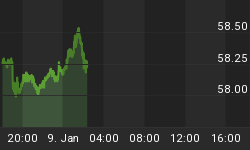Introduction
Last week's "Mixed Signals" seems to be reflective of the narrow 4 week trading range that the market now finds itself in. But clues to market direction are surfacing.
What are those clues? The first is the $VIX. See figure 1 a weekly chart of the SP500 with the $VIX in the lower panel. The black dots over the $VIX data are key pivot points that define support and resistance areas. A break of support in the $VIX should be accompanied by higher prices in the index. Conversely, a break above of a resistance level should be consistent with lower equity prices. For the past year, the $VIX has been unable to break below the 12 level. The failure of the $VIX to close decisively below the 12 level and confirm the price action, which has been moving higher, is a noteworthy negative divergence that remains uncorrected.
Figure 1. $VIX/ weekly
A more important tell has been the recent price action in the $VIX. A week ago, the $VIX did close below the most recent key pivot point level at 12.22, but this break down was quickly reversed as the $VIX is now at 12.44 and back above the key pivot point level. See figure 1 above. Such reversals -- i.e., below a key pivot point and immediately back above again -- in the $VIX should be watched carefully. Looking at figure 2 below, the red dots over the SP500 price bars are those times that the $VIX reversed from below a key pivot point to back above. Such action in the $VIX has marked every top/ pullback of significance in the past 2 years.
Figure 2. $VIX/ weekly
Another clue comes from the Rydex market timer. See figure 3 below, which is a weekly chart of the SP500 with the Rydex Total Bull to Total Bear ratio in the lower panel. If there is one group of market timers who actually have timed this market well over the past 4 years, it has been (oddly enough) the Rydex market timers. The indicator is rolling over, which is a sign that these market timers are becoming less bullish. As figure 3 shows, crosses of the indicator below the signal line (at a high value) have been consistent with a market top over the past 2 years.
Figure 3. Rydex Total Bull/ Bear
So what should we do? In my opinion, these clues are a sign of being late in the rally. They should be respected. Should it be another "run for the hills the market is going to crash kind of moment"? The answer to that question I don't know. From my perspective, I refer to our equity model, which is based upon the "dumb money" indicator (shown in figure 5). The model remains bullish, and will likely remain so for another 2 weeks or more. Exit signals typically occur a week or 2 after investor sentiment has unwound. In essence, we are selling to those investors late to the rally and whom are buying the initial dip after investor sentiment has unwound. The clues cited above are early signs of investor sentiment unraveling. At these levels of bullish sentiment, fewer bulls isn't a contrarian signal but a sign that there are fewer investors willing to push the market higher.
We have been bullish for 19 weeks now when we became bullish during a period of extreme investor bearishness, and it is our expectation that this trade should last on average 15 weeks. So we are in the late stages of the rally. The best, most accelerated gains typically occur in the beginning of the trade. Just when investors typically get the all clear, the trend will flatten out. (Does this sound familiar?) As a reminder, we have moved our stop loss up to SP500 1706.92.
The Sentimeter
Figure 4 is our composite sentiment indicator. This is the data behind the "Sentimeter". This is our most comprehensive equity market sentiment indicator, and it is constructed from 10 different variables that assess investor sentiment and behavior. It utilizes opinion data (i.e., Investors Intelligence) as well as asset data and money flows (i.e., Rydex and insider buying). The indicator goes back to 2004. (Editor's note: Subscribers to the TacticalBeta Gold Service have this data available for download.) This composite sentiment indicator moved to its most extreme position 10 weeks ago, and prior extremes since the 2009 are noted with the pink vertical bars. The March, 2010, February, 2011, and February, 2012 signals were spot on -- warning of a market top. The November, 2010 and December, 2012 signals were failures in the sense that prices continued significantly higher. The current reading is neutral but heading towards bearish (as in too many bullish investors).
Figure 4. The Sentimeter




















